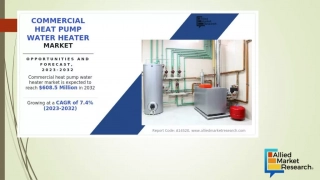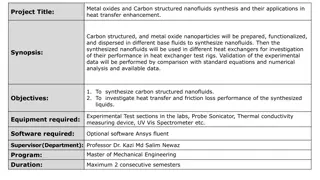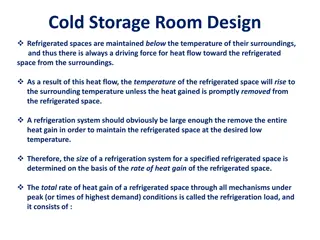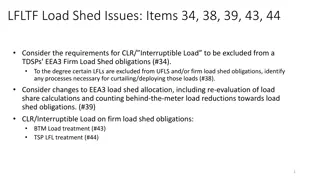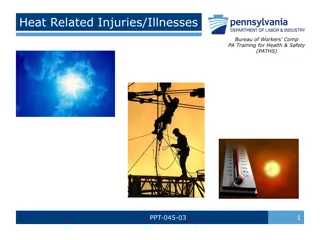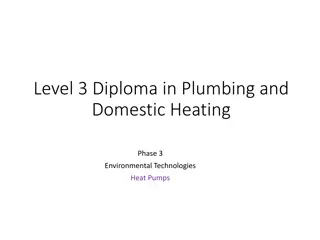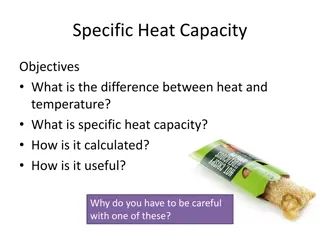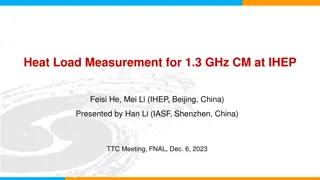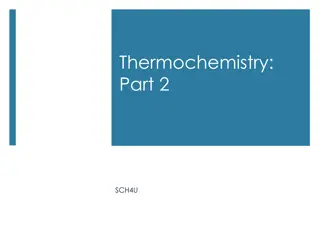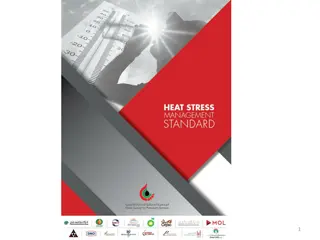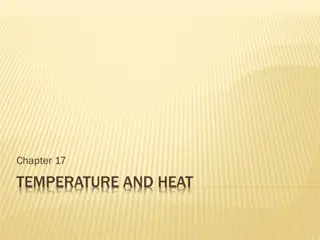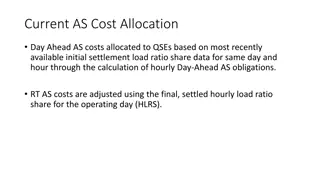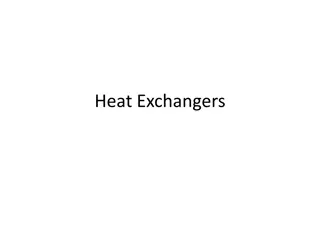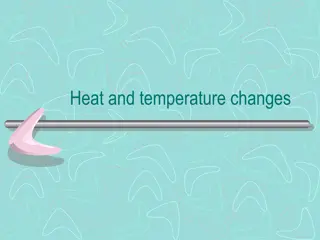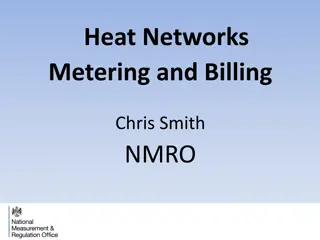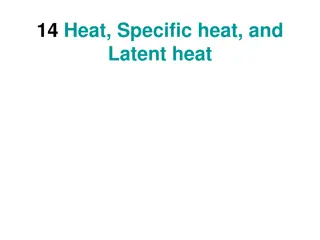commercial heat pump water heater market
Heat pump water heaters are used to move heat from the source to a sink, by utilizing electricity instead of generating heat directly. Heat pumps are used to facilitate the movement of thermal energy by absorbing heat from a cold space and release it. Further, several commercial businesses such as h
2 views • 6 slides
Applications of Heat Exchangers in Various Industries
This topic delves into the diverse applications of heat exchangers in different industries and plants, elucidating the use of various types of heat exchange systems and their importance in processes like bio-processing, power generation, and more. The lecture covers heat exchange applications for li
0 views • 24 slides
Understanding How to Read a Load Chart for a 100-ton Crane
Load charts are essential for determining safe lifting capacities of cranes in construction and heavy machinery operations. This guide explains how to interpret load charts based on factors like boom length, operating radius, and load weight, ensuring safe and efficient crane operations. Learn to id
5 views • 7 slides
Energy and Heat Transfer Problems Explained
Solve various physics problems related to heat transfer, specific heat, latent heat, and efficiency in heating devices. Calculate the amount of heat needed to raise the temperature of different substances, melt solids, and evaporate water. Explore concepts like specific heat, latent heat of fusion,
2 views • 25 slides
Improving Heat Rate Efficiency at Illinois Coal-Fired Power Plants
Heat rate improvements at coal-fired power plants in Illinois are crucial for enhancing energy conversion efficiency, reducing carbon intensity, and minimizing pollution. By increasing the heat rate/efficiency by 6%, these plants can generate more electricity while burning the same amount of coal. T
2 views • 11 slides
Insights on Outdoor Heat Exposure: OSHA Data Collection Pilot 2022
The Occupational Safety and Health Administration (OSHA) conducted a Data Collection Pilot from June to September 2022 to quantify outdoor heat exposure and assess employer heat illness prevention programs. Key findings include identifying elements of successful prevention programs, comparing workpl
0 views • 22 slides
Heat Injury Prevention and Hydration Tips for Safety at Work
Discussing the importance of heat injury prevention, this content provides valuable guidelines on recognizing heat-related issues, staying hydrated, and maintaining a safe environment in challenging weather conditions. Tips include monitoring the heat index, using heat stress thermometers, providing
1 views • 7 slides
Occupational Heat Exposure Control and Prevention Practices
Occupational Heat Exposure Control and Prevention Practices at the New Mexico Institute of Mining and Technology covers training for workers exposed to excessive heat, pre-test evaluation, objectives focusing on heat stress and exposure, understanding heat and heat stress, human body's response to h
1 views • 37 slides
Understanding Heat, Temperature, and Energy Transfer
Delve into the concepts of heat and temperature, exploring their relationship and implications in energy transfer. Discover the significance of heat capacity, specific heat capacity, and how mass influences the heating and cooling rate of substances. Learn how to calculate heat using specific heat c
3 views • 12 slides
Understanding Bridge Loading and Rating
Bridges are subjected to various types of loads such as dead load, live load, and other loads like wind and temperature effects. Dead load consists of the bridge's self-weight, while live load includes temporary moving loads. Bridges are rated to determine their load carrying capacity, especially in
0 views • 21 slides
Advanced Research in Nanofluids and Heat Transfer Enhancement
This project focuses on synthesizing carbon structured and metal oxide nanoparticles to create nanofluids for use in heat exchangers. The research includes investigating heat transfer performance, friction loss, and drag reduction of the synthesized fluids. Additional studies involve exploring novel
0 views • 5 slides
Understanding Refrigeration Load and Transmission in Cold Storage Room Design
Refrigerated spaces require a sufficient refrigeration system to remove heat gain and maintain low temperatures. The refrigeration load includes transmission, infiltration, product, internal, and equipment loads. Transmission load depends on materials, construction, surface area, and temperature dif
1 views • 25 slides
Understanding LFLTF Load Shed Issues and Allocation Process
Explore the complexities of excluding CLR/Interruptible Load from a TDSP's EEA3 Firm Load Shed obligations and the necessary processes for managing load curtailment. Learn about the load shed allocation process, foundational assumptions, and a problem scenario involving load consumption during peak
1 views • 9 slides
Understanding Transmission Operator Obligations in Under-Frequency Load Shedding
ERCOT Compliance ensures that Transmission System Operators (TSOs) and Distribution System Operators (DSOs) have automatic under-frequency load shedding circuits in place to provide load relief during under-frequency events. The TSOs are required to shed a specific percentage of their connected load
0 views • 6 slides
Understanding Heat and Temperature in Thermodynamics
Thermal energy transfer, heat, and temperature play crucial roles in determining the behavior of systems in terms of kinetic energy and molecular motion. The zeroth law of thermodynamics establishes the relationship between heat and temperature. Heat transfer leads to changes in the average kinetic
8 views • 8 slides
Extreme Heat Preparedness and Impacts: CERT Hazard Annexes
Introduction to CERT Hazard Annexes focusing on extreme heat, discussing heat-related illnesses, impacts of extreme heat, and preparedness measures including insulation, window protection, and attic fans. The content emphasizes the preventable nature of heat-related illnesses and the vulnerabilities
0 views • 26 slides
Understanding Heat-Related Injuries and Illnesses in the Workplace
Learn about different types of heat injuries/illnesses, prevention tips, statistics, and who is affected by heat-related issues. Discover how heat stress occurs, the body's cooling system, and the dangers of heat stroke. This comprehensive guide will help you understand how to work safely in the sun
3 views • 46 slides
Understanding Heat Pumps and Their Efficiency
Heat pumps are essential in modern environmental technologies, transferring heat from one area to another efficiently. They work on a refrigeration cycle principle, converting low-temperature heat to higher temperatures. The heat pump system's efficiency is measured by the Coefficient of Performance
0 views • 124 slides
Understanding Heat Transfer in Science
Investigate and understand the movement of heat between objects through conduction, convection, and radiation. Learn to compare materials that conduct heat with insulating materials, describe heat transfer processes, and design experiments to study heat energy movement. Explore the use of ratio reas
0 views • 31 slides
Exploring Measurement Challenges and Concepts in Grade Five Mathematics
Delve into a variety of measurement challenges in Grade Five mathematics, including different units, common errors, measurement components, big ideas, accuracy, precision, and the measurement process. Understand the nuances between accuracy and precision, factors affecting measurement accuracy, and
0 views • 39 slides
Understanding Heat Transfer Mechanisms
Heat transfer is a fundamental concept in physics, involving the movement of thermal energy between objects. This interactive content explores different types of heat transfer such as conduction, convection, and radiation. It discusses how heat is measured, the properties of various materials in con
0 views • 4 slides
Understanding Enthalpy and Heat Capacity in Chemistry
Enthalpy is a measure of total energy in a system, represented as H = E + P.V. Heat at constant pressure relates to enthalpy changes. Calorimetry and heat capacity help measure and understand heat in chemical reactions. Specific heat capacity and molar heat capacity play key roles in determining ene
0 views • 16 slides
Understanding Heat-Related Illnesses in Sports Medicine
Hyperthermia is a condition where body temperature is elevated, posing risks like heat stress and heat-related illnesses. Proper knowledge of factors like temperature, humidity, and hydration is crucial for athletes and coaches to prevent such conditions during workouts. Metabolic heat production, c
1 views • 29 slides
Fault-tolerant and Load-balanced VuFind Project Overview
Project Background: Part of the National Digital Library initiative, the VuFind project aims to provide a discovery interface for Finnish archives, libraries, and museums. It started development in 2012 due to the insufficiency of existing commercial products. The focus is on enhancing fault toleran
1 views • 19 slides
Cloud Load Balancing Overview and Requirements
This content provides a detailed overview of cloud-scale load balancing, involving components like servers, hypervisors, VMs, VIPs, DIPs, and the role of load balancers in distributing workloads efficiently. It also discusses communication flows involving VIPs, DIPs, front-end VMs, back-end VMs, and
0 views • 35 slides
Dynamic Load Balancing in Block-Sparse Tensor Contractions
This paper discusses load balancing algorithms for block-sparse tensor contractions, focusing on dynamic load balancing challenges and implementation strategies. It explores the use of Global Arrays (GA), performance experiments, Inspector/Executor design, and dynamic buckets implementation to optim
1 views • 32 slides
Understanding Specific Heat Capacity and its Importance in Heat Transfer
Discover the key differences between heat and temperature, grasp the concept of specific heat capacity, how it is calculated, and its practical applications in energy transfer processes. Be cautious with hot objects like an apple pie to avoid burns. Explore how specific heat capacity influences the
0 views • 17 slides
Cryogenic Heat Load Measurement and Calibration at IHEP
Researchers at IHEP in Beijing, China, conducted heat load measurements for a 1.3 GHz Cryomodule, analyzing uncertainties in flow rate readings and calibrating mass flow rates. The study involved static and dynamic heat load measurements, utilizing various control interfaces and valves. Calibrations
0 views • 9 slides
Understanding Thermochemistry: Heat, Physical Changes, and Methods of Measurement
Thermochemistry delves into heat, physical changes, and various methods of measuring enthalpy, including calorimetry, Hess's Law, standard enthalpy of formation, and bond energies. Specific heat capacity is crucial for determining the amount of heat absorbed or released during a temperature change.
1 views • 27 slides
Development of Heat Stress Management Standard for Workforce in Hot Environments
As per Ministerial Decisions, a Heat Stress Management Committee was established to create a standard for protecting workers in hot environments. The document focuses on various aspects including heat balance, heat-related illnesses, controls, measurement, medical monitoring, and more. Engineering a
0 views • 17 slides
Understanding Heat Stress and Prevention Techniques
Heat stress can lead to various heat-related illnesses and affect concentration at work. It's essential to be hydrated, wear appropriate gear, and monitor symptoms to prevent heat-related issues. Factors like hydration levels, environmental conditions, and personal health play a crucial role in mana
0 views • 11 slides
Understanding Temperature, Heat, and Energy Transfer
Explore the concepts of temperature scales, absolute zero, heat transfer, units of heat, equivalence between heat and energy, specific heat capacity, and more. Learn about the relationship between heat, energy, and temperature in an engaging visual format.
0 views • 29 slides
Cost Allocation Strategies for Ancillary Services in Electricity Markets
Cost allocation for Ancillary Services (AS) in the electricity market involves distributing costs to Qualified Scheduling Entities (QSEs) based on load ratio share data. Two options are presented: one calculates separate hourly Real-Time Co-optimized Load (RCL) and Non-RCL Load Ratio Share (LRS) for
0 views • 5 slides
Octavia Project Overview and Updates
Octavia is a network load balancing service in OpenStack that provides scalable, on-demand, and self-service access to load balancer services. The project has evolved to encompass all network load balancing and offers key features such as flexible network topologies, highly available load balancers,
0 views • 11 slides
Understanding Accounting Research Methods: Measurement and Sampling
Measurement is a crucial aspect of research in accounting. It involves assigning numbers to empirical events, objects, or properties. Measurement consists of selecting measurable phenomena, developing mapping rules, and applying these rules appropriately. The process of measurement includes determin
0 views • 63 slides
Understanding Sterilization Methods and Equipment for Pharmaceutical Products
Sterilization is crucial in the production of sterile pharmaceuticals, involving the removal or destruction of microorganisms to ensure product safety. Methods include physical (moist heat, dry heat, irradiation), chemical (gaseous, liquid sterilants), and non-thermal techniques like ethylene oxide
0 views • 35 slides
Understanding Heat Exchangers in Food Operations and Equipment
Explore the world of heat exchangers used in food operations, including pasteurization, blanching, evaporation, drying, sterilization, freezing, and extrusion. Learn about different types of heat exchange equipment such as double tube heat exchangers, shell and tube heat exchangers, and plate heat e
0 views • 40 slides
Understanding Heat and Temperature Changes in Chemistry
Heat and temperature changes in chemistry are crucial concepts to comprehend. Heat capacity, molar heat capacity, and specific heat capacity play significant roles in determining temperature changes when heat energy is added or removed. Different substances have varying abilities to absorb heat, aff
0 views • 17 slides
Guidelines for Heat Networks Metering and Billing in Buildings
Guidelines for heat networks metering and billing in buildings cover regulations, scopes of district heat networks and communal heating, duty to install meters or HCAs, meter viability and accuracy, and requirements for new buildings and major renovations in both district heat and communal setups. T
0 views • 19 slides
Understanding Heat, Specific Heat, and Latent Heat
Heat is energy transferred between objects due to temperature difference. Specific heat capacity measures the amount of heat needed to change the temperature of a substance. Latent heat is the energy required for a phase change without a temperature change. Calorimetry and measuring specific heat ar
0 views • 14 slides
